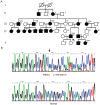A novel frameshift mutation in CX46 associated with hereditary dominant cataracts in a Chinese family
- PMID: 28546921
- PMCID: PMC5437452
- DOI: 10.18240/ijo.2017.05.04
A novel frameshift mutation in CX46 associated with hereditary dominant cataracts in a Chinese family
Abstract
Aim: To investigate the genetic mutations that are associated the hereditary autosomal dominant cataract in a Chinese family.
Methods: A Chinese family consisting of 20 cataract patients (including 9 male and 11 female) and 2 unaffected individuals from 5 generations were diagnosed to be a typical autosomal dominant cataract pedigree. Genomic DNA samples were extracted from the peripheral blood cells of the participants in this pedigree. Exon sequence was used for genetic mutation screening. In silico analysis was used to study the structure characteristics of connexin 46 (CX46) mutant. Immunoblotting was conduceted for testing the expression of CX46.
Results: To determine the involved genetic mutations, 11 well-known cataract-associated genes (cryaa, cryab, crybb1, crybb2, crygc, crygd, Gja3, Gja8, Hsf4, Mip and Pitx3) were chosen for genetic mutation test by using exon sequencing. A novel cytosine insertion at position 1195 of CX46 cDNA (c.1194_1195ins C) was found in the samples of 5 tested cataract patients but not in the unaffected 2 individuals nor in normal controls, which resulted in 30 amino acids more extension in CX46C-terminus (cx46fs400) compared with the wild-type CX46. In silico protein structure analysis indicated that the mutant showed distinctive hydrophobicity and protein secondary structure compared with the wild-type CX46. The immunoblot results revealed that CX46 protein, which expressed in the aging cataract lens tissues, was absence in the proband lens. In contrast, CX50, alpha A-crystallin and alphaB-crystallin expressed equally in both proband and aging cataract tissues. Those results revealed that the cx46fs400 mutation could impair CX46 protein expression.
Conclusion: The insertion of cytosine at position 1195 of CX46 cDNA is a novel mutation site that is associated with the autosomal dominant cataracts in this Chinese family. The C-terminal frameshift mutation is involved in regulating CX46 protein expression.
Keywords: autosome dominant heredity; cataract; congenital; connexin 46; genetic mutation; ocular lens.
Figures



References
LinkOut - more resources
Full Text Sources
Other Literature Sources
Research Materials
